Creating a Comic Book? Here’s some Advice from a Printer
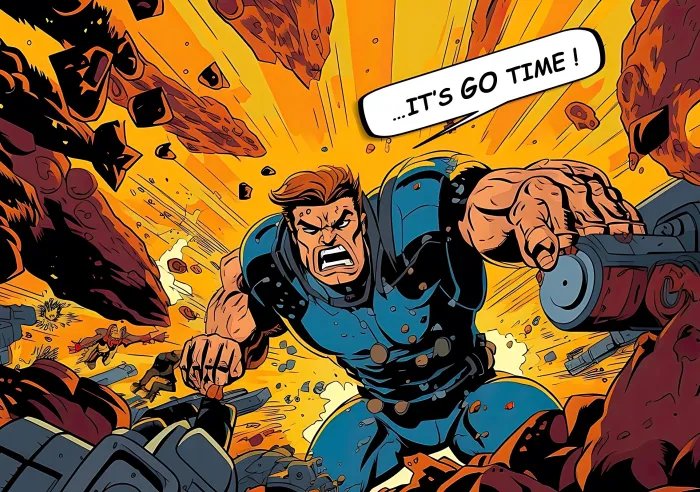
estimated reading time: 19 minutes
A Quick Word from Color Vision Printing...
Color Vision is a full-service, totally custom printer. We've been a trusted printing partner to independent comic creators and publishers for over four decades. So we know how much time, passion, and creativity people invest in the planning, writing, and illustrating of a comic book.
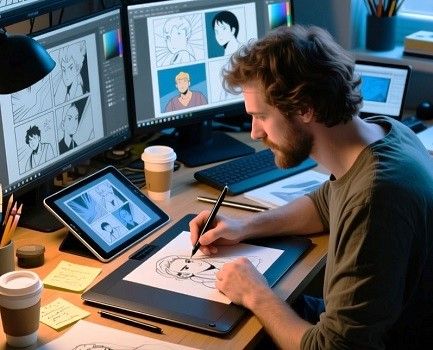
By offering high-quality printing at affordable prices, we
have helped numerous artists and writers turn their visions into reality. Now
we're ready to help you, too.
If you are planning to create a comic book and have questions about bringing your artwork to life in printed form, this article is for you.
Below you will find answers
to popular questions about comic book printing, including project
specifications, print processes, and more.
Should you have any additional questions, just give us a
call at 800-543-6299 or contact us online. We're always happy to help.
Answers to Popular Questions about Comic Book Printing:
What is the Best Printing Method for Comic Books - Offset or
Digital?
Both the Offset and Digital printing methods produce excellent results. Which method is the better fit for your particular comic book project will largely be determined by the quantity of books you are planning to print.
Generally speaking, Digital Printing will be the more
cost-effective option for smaller order quantities and Offset printing will be
more cost-effective option for higher order quantities.
Let's explore these two production methods in more depth to
learn why the order quantity has such a significant effect on the unit cost of
a comic book project.
Offset Printing is the traditional form of printing, where
the ink is actually pressed onto the paper. The Offset printing method requires
the creation of printing plates, which are sheets of aluminum or polyester that
have been etched with the images to be printed. Every ink color used for the
project receives its own unique printing plate(s).
Modern offset systems use computer-to-plate (CTP)
technology, which transfers the digital artwork files directly to the printing
plates. However, applying the ink to the paper is not a digital process; it is
a mechanical process that involves a series of rotating cylinders.
In addition to the creation of printing plates, an Offset
press requires a detailed set-up process before the actual print run can begin.
This process, known as "Make Ready" helps to verify all the ink
colors are in register with each other and are producing vivid images on the
paper.
Though the Make Ready process is necessary to ensure the
press is operating at peak efficiency, it adds time and labor to the front end
of an Offset print run. Make Ready also consumes a fair amount of paper used as
test sheets. However, once the Make Ready tasks are complete and the press
begins the actual production phase, it operates with great speed and
efficiency, thus bringing down the unit cost of each comic book as the press
continues to run.
The cost of creating printing plates, as well as the set-up
costs associated with the Make
Ready process, prevents Offset printing from being an economical
choice for smaller book orders. This is because the upfront costs cannot be
distributed over enough units to make a smaller book project cost effective.
On the other hand, a larger order can absorb these upfront
costs because the costs are distributed across more units. This means once an Offset
press is up and running, the unit cost goes down with each impression. The
initial set-up costs may be high, but the cost of applying ink to paper is
minimal once the press is in operation.
Hence, Offset printing is extremely cost-effective when
printing comic books in bulk. As far as an actual order volume, the generally
accepted recommendation is that an Offset press will provide the best value for
projects of 1,000 books or more.
Unlike the Offset method, Digital Printing does not use
printing plates. The artwork files, which have been created on a computer and
exist in electronic form, are transferred directly to the printing press for
output.
Most commercial Digital printing presses operate with either
laser or inkjet technology. A laser printing press fuses powdered toner to the
paper substrate, whereas an inkjet printing press applies tiny droplets of liquid
ink.
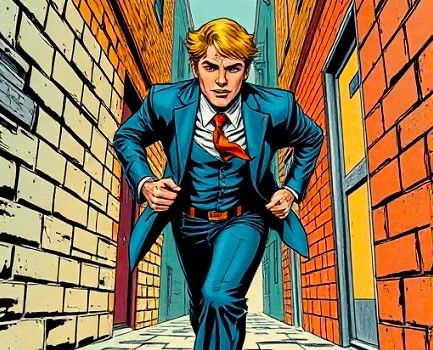
Because Digital presses can output directly to the
substrate, this method does not incur the upfront costs associated with plate
creation or an extensive make-ready process. This means there is no upfront
cost burden to overcome. As such, large quantities do not need to be produced
in order to absorb any upfront costs. The production cost of the first print
made on a Digital press run is pretty much the same as the cost of the 50th or
500th print. Hence, any savings from the economies of scale are limited when
printing on a Digital press.
The bottom line is that Digital printing is more
cost-effective than Offset printing when printing books in smaller quantities.
The generally accepted recommendation is that a Digital press provides the best
value for book projects that have an order quantity less than 1,000 units. For
many years, the recommended quantity for Digital printing was 500 units or
less, but in recent years the price of Digital printing has become more
affordable for quantities approaching 1,000.
So what does Color Vision suggest for comic creators just
starting out? Our suggestion for new book launches is to start off using Digital
printing services. Then as you gain more readership and your order quantities increase,
consider switching to Offset printing to take advantage of the economies of
scale. You will be amazed how much Offset printing will decrease the unit cost
at higher production volumes.
By the way, Color Vision has both types of printing presses
- Offset and Digital. Having both production methods in-house allows us to print
a broader range of book projects at affordable rates, so we can accommodate
your initial start-up needs as well as produce your comics in volume as you
grow.
What is the Minimum Order Quantity (MOQ) for Comic Books?
As you might expect, the Minimum Order Quantity (MOQ) varies from printer to printer. For example, printers that operate Digital presses usually have minimums in the range of 25 to 300 books. Some will even print a single book on demand, but the unit price for that one book can be rather steep.
Printers that only have
offset presses will need more volume to make the production run cost effective,
so their minimum for offset production might be as high as 1000 books to be
able to offer the best unit price.
Regardless of the production method, the unit cost will
always be higher at lower production quantities and lower at higher production
quantities.
Though Color Vision doesn't offer on-demand book printing or produce single copies, we will provide comic book quotes for quantities as
low as 25 copies. That said, one thing to keep in mind is that every print shop
has different equipment and capabilities, so each has its own "sweet spot"
where the pricing is most competitive.
Because Color Vision has both Digital and Offset presses,
our sweet spot for printed books is within the range of 100 to 5000 units. We
are confident you will be very pleased with our pricing for projects within
this quantity range.
What Size should my Comic Book Be?
The most popular size for modern American comic books is 6.625" wide x 10.25" high. This refers to the finished size, after the pages have been trimmed during production.
Though less common, other sizes used for comics include the
5.5" x 8.5" digest size and the 8.5" x 11" magazine size. Comics created in the Japanese Manga style are normally sized at 5" x 7.5"
You may have noticed that many online printers offer a
narrow set of comic book sizes from which you must choose. However, some
printers - like Color Vision - offer custom sizes in addition to standard
sizes.
Being a totally custom printer, Color Vision can create your
comic in whatever size or orientation you desire. This means the physical size
of your comic book is totally up to you, allowing you to choose unique dimensions
that will set your book apart.
What Type of Binding should I Use?
Since the early days of comic books, two binding methods
have remained at the forefront - Saddle Stitch
Binding and Perfect Binding. Though these two methods have vastly
different production processes, both provide a practical and economical binding
solution.
To help you determine which of these binding methods is a
better fit for your particular project, we have provided a detailed explanation
of each method below…
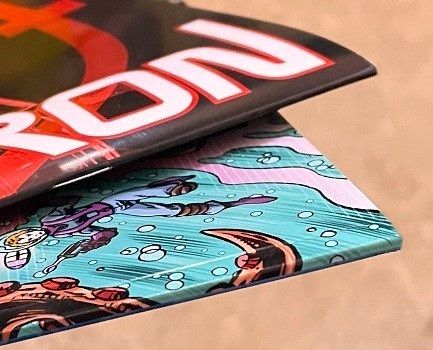
Saddle Stitch Binding uses wire staples to join a comic
book's cover and pages together. After the page sheets have been printed, they
are partially folded and then draped over a saddle-like apparatus where the
sheets nest together as each falls into place. Each folded sheet creates four
pages of the comic book.
After all the folded page sheets have been compiled in the
proper order, a folded cover sheet is applied over the page assembly. Several
wire staples (usually two) are then driven through the fold line of the assembled
sheets. The staples first penetrate the outside cover, then pass through every
interior sheet until they pierce the innermost sheet.
The staples are then cinched closed in the fold line of the
innermost sheet. The staples hold the pages and cover tightly together, while
allowing the pages and cover to turn freely. After the book has been stapled,
it is folded tighter together and the open edges of the book are trimmed as
needed.
The stapled fold line of the assembled sheets is what forms
the book's spine. Because the resulting spine is quite narrow, there is not
enough room to print text on the spine of a saddle stitched book. However, the
narrow spine allows saddle stitched books to lie relatively flat when opened.
The saddle-stitch binding method works best for comics with
lower pages counts. This is because wire staples can only secure a given number
of pages. Trying to bind too many pages with staples can create excessive bulk
and tension near the spine. This leads to a bulging effect that prevents the
comic book from lying flat. So, our recommendation is to only use the
saddle-stitch method to bind a maximum of 60 pages if you prefer a nice flat
comic.
A big benefit of the saddle stitch binding method is its low
cost. In fact, it is the cheapest binding method available. Despite its low
cost, it produces securely bound and professional-looking comic books. This
helps explain why, decade after decade, saddle stitching has remained a
prevalent style of comic book binding.
Unlike saddle-stitching, which uses a mechanical fastening
method, the Perfect Binding process uses a special hot-melt adhesive
to secure the pages into a wraparound cover. The adhesive provides a strong
bond but remains flexible after it has set up.
The perfect binding process is slightly more involved than the saddle-stitching
process. After the pages of the comic book have been printed, they are collated
into a compact stack. This stack is known as the page block. Each sheet within
the block creates two pages of the book.
After the page block has been assembled, the spinal edge is
notched or "roughed up" using a machine with rotating blades. These
sharp blades expose more paper fibers, thus providing additional surface area
for the adhesive to make a stronger bond.
By this point in the process, the cover of the comic book
will have already been printed. Depending on the specs of the project, the
book's cover may have also received a durable clear coat or other
enhancements. The cover will also be scored and creased so it will fit
snugly around the page block.
Once the page block and cover have been prepared, hot-melt
adhesive is applied along the spinal edge of the page block. The block is then
affixed to the center of the inside cover. Next, the cover is wrapped tightly
around the page block.
Once the glue sets, the comic book undergoes a trimming
operation. The three open sides of the book are trimmed to ensure the pages are
uniformly straight. These arrow-straight edges are where "perfect
binding" gets its name.
Whereas saddle stitch binding is well-suited for comic books
with lower page counts, perfect binding is ideal for comic books and graphic
novels with medium to high page counts. In fact, the perfect binding method is
not recommended for books thinner than .125". This is because the glue
needs a bonding surface of at least .125" in width to ensure strong
adhesion.
A big advantage of perfect binding is that it produces a
square spine. If the resulting spine is wide enough to accept printed text of a
legible size, it can be printed with the comic book's title, author(s), volume
number, or other identifying information.
As far as cost is concerned, perfect bound books are not
quite as cheap as saddle-stitched books but they are still very affordable.
Also, the square, printable spine and crisp edges help to enhance the value.
Though saddle stitching and perfect binding are by far the
most popular binding styles for comic books, there are other binding styles
available. For example, Hardcover Binding is sometimes used for deluxe
editions. Though hardcover binding is very durable, it sells at a premium
price. Other binding methods, such as Spiral Coil or Wire-O binding allow books
to lie perfectly flat when opened. However, like the hardcover method, these binding
types are not considered a mainstream choice for comics and are generally
reserved for special editions.
What Kind of Paper should I use for the Interior Pages and
the Cover?
Choosing the right paper for your comic book is one of the
most important decisions you'll make in the printing process. The thickness,
texture, and finish of the paper you choose will have a big impact on the
appearance and feel of your comic book. Though some printers only offer a
limited paper selection, totally custom printers are able to produce comics using
any type or weight of paper you choose.
The two primary classifications of paper are Coated and
Uncoated.
Gloss Coated stocks have a slick and shiny finish that will
make ink colors appear more vibrant. Gloss coated stocks are great for
showcasing full-color artwork, especially for comics oriented toward action or
excitement.
Matte Coated stocks have a smooth but minimally reflective
finish. Colors appear softer on a matte stock. As such, text-heavy comics and
graphic novels will be easier to read because of the reduced glare.
Uncoated stocks offer a flat look with zero sheen. These stocks also
have a rougher texture with a more natural paper feel, like the pages of vintage
comics. Ink colors will appear somewhat subdued on an uncoated stock but the
natural paper texture offers a more tactile experience. Uncoated stocks are a
good choice for black-and-white printing or retro style artwork.
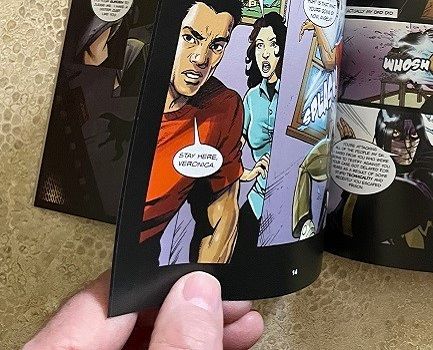
Regarding the thickness of paper used for custom comic
books, there are lighter text weights and heavier cover weights from which to
choose. The heavier the paper weight, the more durability it offers against
frequent handling. Heavier paper weights
also offer more opacity to prevent artwork from showing through to the other
side of a sheet.
The most popular options for the interior pages include the
text weights of 60 lb, 70 lb, or 80 lb. Cover weights range from 80 lb to 130
lb, with the heavier weights usually reserved for the covers of comic books
made with the perfect binding method.
If you are unsure of which paper to use, Color Vision will
be happy to help you choose the paper that best aligns with the other specs
of your project. You can also mail us a comic that has the look and feel you want
to replicate and we will be happy to spec out the weight and sheen level of its
pages and cover for you.
While we're on the subject of paper, we wanted to bring up
the "Self Cover" option. The majority of comic books are ordered with a cover
that is thicker than the paper used for the inside pages. However, many
comic books are ordered as "Self Cover" books.
Self Cover simply means the same paper stock is used to
create the entire book. In other words, the exterior cover and interior pages
are printed on the exact same type and weight of paper. For example, 70# gloss
text throughout.
The cover could be a lighter weight to match the pages, or
the pages could be a heavier weight to match the cover. Either way, the
self-cover option provides some cost savings because the entire book can be
printed and assembled all at once, as opposed to requiring two separate
production runs for the cover and pages.
Technically, any softcover binding style can be used in
conjunction with the self-cover option. However, saddle-stitching is the
binding method most frequently used to create self-cover books.
Should I Print my Comic Book in Full Color or use Black Ink Only?
Whether you design your comic book to print in full color or
black ink depends on your artistic vision, the expectations of your target
audience, and your budget. Here's a quick breakdown to help you decide…
Full Color Printing is the predominant choice for modern US
comics because it offers tremendous visual impact. Full color brings characters
and action sequences to life, making scenes more immersive and the story
progression easier to follow. It also helps convey the proper mood and
atmosphere, such as using warm tones for energy and cool tones for tension.
Full color printing is used for genres that rely on vivid, high-impact artwork such as superhero, adventure, fantasy, sci-fi, and children-oriented
comics.
Commercial presses use the 4-color process method to produce
full-color printing. The 4-color process uses only four ink colors - Cyan,
Magenta, Yellow, and Black. Known collectively as CMYK, these four ink colors
are applied in successive layers of tiny ink dots as the paper moves through
the press. The dots intermingle on the sheet to create thousands of different
shades and hues, building vibrant images with rich details.
Black Ink Only (which includes Grayscale and Black-and-White printing) is used for artistic reasons as well as to save money. Because only one
ink color is used - Black - it is a more economical printing method than using
the four ink colors of CMYK. In addition to black ink costing significantly
less than full color printing, the file sizes are also smaller and the
production runs are more streamlined.
As its name implies, Grayscale uses varying shades of gray
to produce images. Unlike full color images that are created from the four
different CMYK ink colors, grayscale images are produced solely from black ink.
The black ink appears in concentrations ranging from 0% black to 100% black.
This wide range - from the faintest gray to the darkest charcoal - provides the tonal variations needed to accurately represent the images.
Despite being devoid of color, Grayscale images still provide a high level of detail.
Black-and-White printing is similar to grayscale in that it
only uses black ink. However, with strict black-and-white printing there are no shades
of gray. The black ink is applied at full strength, with the base paper color
providing the white contrast.
Both Grayscale and Black-and-White printing can give comic
books a gritty, edgier look. As such, these techniques are often used in
conjunction with scary, dark, or suspenseful storylines such as those found in
the genres of horror, crime, or mystery. Also, comics done in the Manga style
are usually created using only black ink for the pages.
As mentioned, printing with black ink is more economical than printing in full color. Often, the cover of a comic book is printed in full color while the interior pages are printed with black ink. This color combination provides the benefit of having an eye-catching cover with the cost savings of using black ink for the pages.
The affordability of printing in black ink, whether used for the entire book or just the interior pages, makes it a good option for new creators trying to establish a following. Once the audience becomes more established, creators can transition to full color printing for future editions if they so choose.
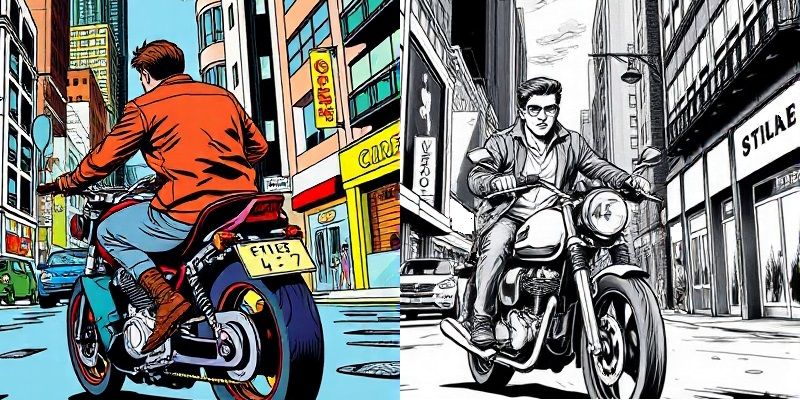
What Special Finishing Options are Available for Covers?
In printing, "Finishing" refers to special enhancements
that can be added to printed pieces after the ink has been applied. Since the
cover is the first thing people see when looking at a comic book, most finishing options are applied to the cover.
The primary goal of adding a finishing step is to amplify visual appeal, creating a strong "wow" factor that not only commands immediate attention but also leaves a
lasting impression. In addition to boosting the physical appearance of a comic,
some finishing techniques can also enhance the texture and durability.
If you are looking to add a level of customization to your
comic book, below are some finishing options for you to consider…
High-Gloss Finish: A high-gloss finish can be obtained by either
applying a gloss UV coating or a gloss laminate film. The glass-like sheen
created by these treatments enhances the depth and intensity of the underlying
ink colors, making them appear even more vibrant and visually striking. The
slick surface of a gloss finish also helps extend the life of a comic by
repelling smudges, grime, and scuffs.
Spot UV: A gloss Spot UV coating can be used to highlight
specific areas of the cover artwork by giving these areas a higher sheen level
than the surrounding surface.
Soft Touch Finishes: A soft touch finish appeals to the
sense of touch by providing a velvety or suede-like feel. This finish is
achieved either by using a liquid coating that yields a soft-touch texture as
it dries or by applying a soft touch laminate film. The unusual texture adds
intrigue and heightens the reader's interaction with the comic.
Foil Stamping: The foil stamping process applies metallic
accents to the cover, producing a stunning optical effect. Foil is available in
various colors as well as popular metallic finishes like gold, silver, or
copper.
Embossing/Debossing: Embossing creates a raised design and
debossing creates a recessed design. Both methods produce a 3-dimensional effect.
The paper substrate is placed between two mating die sections and then heat and
pressure is applied to permanently elevate or indent the design. Embossing can
be used in conjunction with Foil Stamping or Spot UV.
Die-Cutting: As the name indicates, die-cutting refers to a
method of cutting shapes into paper, cardstock, and other substrates using a
sharp metal die. The die-cutting process is used to add sculpted edges, rounded
corners, see-thru "windows", and interesting patterns and contours.
What File Format should I Submit?
Almost all printing companies, including Color Vision,
prefer that your artwork files be submitted as high-resolution PDFs. Also, to
maintain print quality, images and artwork should be at least 300 dpi.
Plus, it is especially important that the color mode be set
to CMYK, not RGB. If using any PMS spot colors, be sure to specify the Pantone
numbers.
Bleed should extend 0.125" beyond the trim edge and
crop marks should be properly placed. Additional recommendations from Color
Vision's art department can be found here: How to Submit Artwork
Will my Artwork Files get Checked Over before Printing?
Thoroughly checking artwork files to ensure they are print
ready is vitally important to ensure a successful production run. It is also one of the functions that differentiates full-service
custom printers from many of the automated online printers.
The majority of online printers will assume the artwork file
you submit is print-ready. Hence, their automated systems will only perform checks
on some basic elements, such as file type, page count, and trim size. If your
artwork passes these basic checks, they will print exactly what you sent them…even
if serious issues remain, such as content too close to an edge, color or
resolution settings being off, or an unexpected shift in the page order.
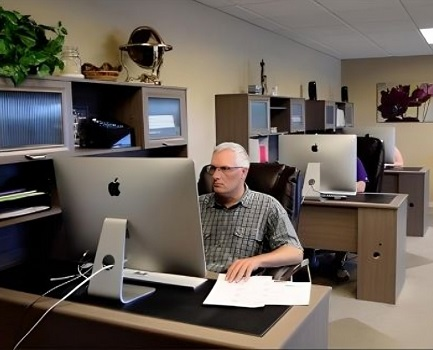
A full-service custom printer will have a prepress department
that will preflight your artwork before the files go to press. This preflighting
process ensures the artwork can be printed successfully. It involves a thorough
inspection of the art for a wide range of potential issues which, if not
corrected, could lead to printing delays, poor quality, or an expensive
reprint.
As a full-service printing company, Color Vision has an
in-house graphics and prepress department to preflight all artwork submitted
with a printing order. If any issues are found, we will communicate these to
you along with our recommendations for remedying them. We'll work closely with
you to ensure your files are print-ready and we will forward a proof to you for
approval. We want you to receive the quality results that you expect.
How Much does it Cost to Print a Comic Book?
Now we come to the big question - how much will it cost? When
it comes to the cost of having comic books printed, there isn't a
one-size-fits-all answer. This is because the printing costs are dependent upon
the specifications of each individual project, such as the order quantity, book
dimensions, page count, binding style, paper and ink choices, plus any optional
features.
Since every comic book project is unique, requesting a
custom quote is really the only way to get an accurate cost for your specific
project. Color Vision is always happy to provide quotes for your projects,
so don't be shy about asking us for a quote. After all, we're here to help you!
To get a price quote, simply use our Quote Request
form to send us your project's specifications and we will email a custom
quote to you. Or, if you prefer to discuss your project by phone, give us a
call at 800-543-6299.
Because Color Vision is a totally custom printer, we can
produce your comic books with any specifications or in any genre you desire.
Just let us know how we can be of service!
Reasons to Buy your Comic Books from Color Vision Printing…
- You will communicate with Real People who are eager to offer guidance
- We are a Totally Custom Printer - your options are virtually unlimited
- We have Digital and Offset presses to accommodate varying run sizes
- Our In-house Prepress Department ensures your files are print-ready
- Extensive Selection of Finishing and Binding Options
- Friendly and Helpful Staff dedicated to your Success
- 40+ Years in the Printing Business
- All Books are printed in the USA
- Excellent Quality and Prices
- A+ BBB Rating
Related Articles

How Much Does It Cost to Have Books Printed?
Read This Article
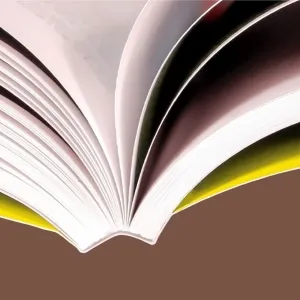
PUR Bound Books: 7 Types of Books that call for PUR Binding
Read This Article
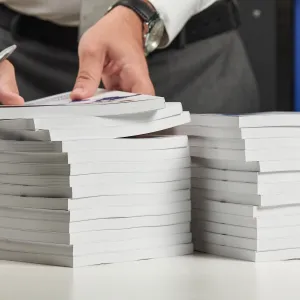
Perfect Bound Books: Exploring the Perfect Binding Process
Read This Article
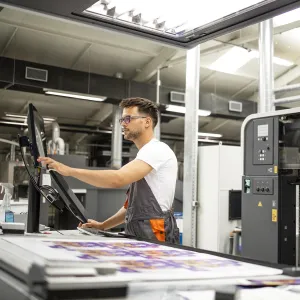
Self-Publishing a Book: How to Choose a Printing Company
Read This Article